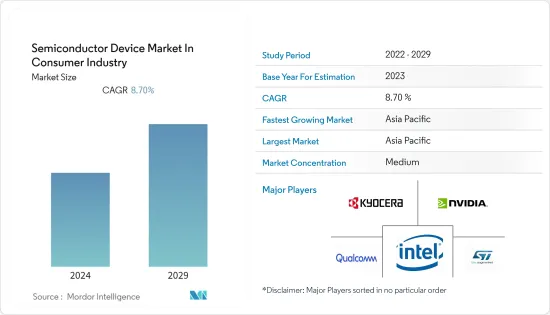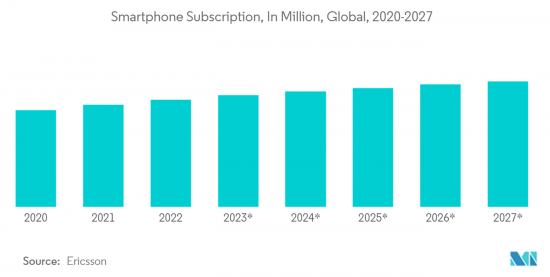
|
市場調査レポート
商品コード
1408768
消費者用半導体デバイス:市場シェア分析、産業動向・統計、2024~2029年成長予測Semiconductor Device In Consumer Industry - Market Share Analysis, Industry Trends & Statistics, Growth Forecasts 2024 - 2029 |
||||||
カスタマイズ可能
適宜更新あり
|
|||||||
| 消費者用半導体デバイス:市場シェア分析、産業動向・統計、2024~2029年成長予測 |
|
出版日: 2024年01月04日
発行: Mordor Intelligence
ページ情報: 英文 120 Pages
納期: 2~3営業日
|
全表示
- 概要
- 目次
消費者用半導体デバイス市場は、今年度834億米ドルで、予測期間にはCAGR 8.7%を記録し、1,269億米ドルに達すると予測されます。

主なハイライト
- 携帯電話、ノートパソコン、ゲーム機、電子レンジ、冷蔵庫など、ほとんどの民生用電子機器は、集積チップ、ダイオード、トランジスタなどの半導体で動作しています。こうした機器の需要が高いことが、市場成長の主な要因となっています。
- 集積回路の使用は、携帯電話や携帯音楽プレーヤーからゲーム・システム、パソコン、その他のデジタル機器に至るまで、マイクロプロセッサー制御の民生用電子機器に広く普及しています。集積回路(IC)またはチップは、シリコンウエハー上の数平方センチメートルの面積に、コンデンサー、トランジスター、抵抗器など多くの電子部品を詰め込んだ極めて高度なデバイスです。
- さらに、消費者向けモノのインターネット(IoT)などの動向の出現が、消費者用半導体デバイス市場の需要を煽っています。民生用IoTの理想的な例はスマートホームで、電子機器、照明、HVACシステム、家電製品がすべて中央ハブから制御・監視されます。IoTアプリケーションは集積回路とセンサーなしでは機能しないため、すべてのIoTデバイスは半導体を必要とし、これが調査した市場に大きな成長の可能性を生み出しています。
- さらに、近年の市場におけるスマートフォンやスマートホームデバイスの爆発的な成長は、消消費者用半導体デバイス市場の需要を促進しています。デジタル機器への第5世代(5G)ワイヤレス技術の採用が増加していることも、コネクテッドデバイスやスマート製品の需要増加の主な要因の1つであり、市場の成長を支えています。
- ロシアとウクライナの戦争は半導体業界のサプライチェーンに悪影響を与えました。SEMIによると、ウクライナと中国はキセノンガスとクリプトンガスの約80%を供給しています。これらのガスは半導体製造に多用され、主に鉄鋼製造や空気分離装置の助けを借りて入手できます。
- 戦争が勃発し、他の地域では専用の空気分離装置がないため、半導体製造のリードタイムは増加しており、調査した業界全体でチップ不足につながっています。
半導体デバイス市場動向
スマートフォンおよびスマート・ウェアラブル・デバイスの普及拡大
- 人口の増加と都市化により、特に発展途上国ではスマートフォンの普及率が高まっており、これが消費者用半導体デバイス市場の需要を促進しています。例えば、GSMAによると、2025年までに、スマートフォンは2019年の65%から、5つの接続のうち4つを占めるようになると予想されています。
- さらに、BankMyCellによると、2022年9月現在、世界のスマートフォンユーザーは66億4,800万人で、世界人口の83.04%がスマートフォンを所有していることになります。スマートフォンやフィーチャーフォンを所有する人の数は72億6,000万人で、世界人口の91.08%を占める。
- さらに、5G技術の普及が進み、5G対応スマートフォンの需要が高まるため、コンシューマー業界の半導体デバイス市場は高成長を遂げると思われます。例えば、GSMAによると、2025年までに5Gネットワークは世界人口の3分の1をカバーする可能性が高いです。5Gワイヤレスセルラーネットワークでは、スマートフォンのバッテリー効率と最適な電力利用が半導体デバイスの成長に寄与する重要な要因として浮上しています。
- スマートウォッチ、スマートリストバンド、フィットネストラッカー、アクティビティトラッカー、スポーツウォッチ、仮想現実(VR)ヘッドセットなどのスマート・ウェアラブル・デバイスは、人工知能(AI)やモノのインターネット(IoT)などの先進技術と統合されており、膨大な数のセンサーや集積回路(IC)を採用しています。例えば、フィットビット、スマートウォッチ、パルスオキシメーターは、リアルタイムで患者の健康を追跡するソリューションを提供する光センサーを組み込んだウェアラブルシステムの一つです。従って、これらのデバイスの使用の増加に伴い、消費者用半導体デバイス市場全体がプラスの影響を受け、着実な成長を示しています。
- 多くのベンダーは、高まる需要に応え、顧客基盤を拡大するため、新製品の開発にも注力しています。例えば、2023年1月、221e srlとSTMicroelectronicsは、221eのセンシングAIソフトウェアとSTMicroelectronicsのマイクロコントローラおよびインテリジェントセンサをベースに、ウェアラブル、IoT、その他のコンシューマアプリケーション向けの人工知能ソリューションを強化するために提携しました。

アジア太平洋が市場を独占する
- 消費者用半導体デバイス市場は、大手コンシューマエレクトロニクスメーカーの存在により、アジア太平洋が支配すると予測されています。同市場は、スマートフォンの普及、5Gの普及、スマート家電の増加によって牽引されると予想されます。
- 複数の世界企業は、アジア太平洋地域を今後の成長が見込まれる主要市場のひとつと見ています。アジア太平洋地域の消費者市場の成長は、主に良好な人口動態と可処分所得の増加によってもたらされます。
- 大規模なメーカーが存在するため、この地域は最大の家電市場のひとつです。消費者産業における半導体デバイス市場の需要は、いくつかの国で家電産業が拡大するにつれて増加すると予想されます。例えばインドは、消費財と最新技術の世界の主要市場のひとつです。India Brand Equity Foundation(IBEF)は、インドの家電・民生用電子機器(ACE)市場がCAGR9%で成長し、2025年には211億8,000万米ドルに達すると予測しています。このような数字が、同地域における製品発売の成長を促進すると推定されます。
- さらに、スマートホームの需要拡大は、エネルギーコストの上昇によって、サーモスタット、照明、スマートコンセントのエネルギー効率とコスト削減ソリューションの採用につながると予想されます。このような市場におけるスマートホームデバイスやスマート電力管理デバイスの需要増加は、この地域の消費者産業における半導体デバイス市場の需要成長を促進すると予想されます。
- さらに、業界の大手企業は、競合に打ち勝つために地域事業の拡大に注力しています。例えば、2023年3月、サムスンは韓国に2,280億米ドルを投資して新しい半導体施設を建設すると発表しました。
半導体デバイス産業の概要
消費者産業の半導体デバイス市場は現在、継続的な統合、技術の進歩、地政学的要因によって大きな変動を経験しています。イノベーションを通じて持続可能な競争優位性を獲得することが最も重要な市場において、競争は激化の一途をたどっています。このようなダイナミックな環境を踏まえると、特に半導体製造分野のエンドユーザーからの品質に対する高い期待を考慮すると、ブランドのアイデンティティが極めて重要な要素となります。
同市場は、インテル・コーポレーション、エヌビディア・コーポレーション、京セラ・コーポレーション、クアルコム・テクノロジーズ・インク、STマイクロエレクトロニクス・エヌ・ヴィ(STMicroelectronics NV)など、市場浸透率の高い大手企業によって支配されています。この競合情勢では、技術革新、市場投入までの時間、性能が業界プレイヤーの主要な差別化要因として際立っています。全体として、競争企業間の敵対関係は予測期間中に着実に高まっています。
2023年4月、ルネサスエレクトロニクスは、先進的な22nmプロセス技術に基づく初のマイクロコントローラ(MCU)を発表しました。この革新的な製品の発表は、コア電圧の低下により消費電力を削減しながら、優れた性能を顧客に提供することを目的としています。
2023年3月、STマイクロエレクトロニクスとウィンボンド・エレクトロニック・コーポレーションは、民生用およびスマート産業用アプリケーション向けのSTM32デバイスに高性能メモリを統合する戦略的パートナーシップを締結しました。このパートナーシップの目的は、ウィンボンドのDDR3ダイナミックRAMとSTのSTM32M P1 MPUを組み合わせることです。これらのMPUは、最大2つのCortex-A7コアを内蔵し、高度なペリフェラル、IoTセキュリティ・ハードウェア、および高効率のオンチップ電力変換集積回路を提供します。
その他の特典:
- エクセル形式の市場予測(ME)シート
- 3ヶ月間のアナリストサポート
目次
第1章 イントロダクション
- 調査の前提条件と市場定義
- 調査範囲
第2章 調査手法
第3章 エグゼクティブサマリー
第4章 市場洞察
- 市場概要
- 産業バリューチェーン分析
- 業界の魅力度-ポーターのファイブフォース分析
- 供給企業の交渉力
- 消費者の交渉力
- 新規参入業者の脅威
- 代替品の脅威
- 競争企業間の敵対関係の強さ
- マクロ動向が業界に与える影響
第5章 市場力学
- 市場促進要因
- 家電分野におけるスマートテクノロジーの普及
- 5Gの普及と5Gスマートフォンの需要増加
- 市場の課題
- サプライチェーンの混乱
第6章 市場セグメンテーション
- デバイスタイプ別
- ディスクリート半導体
- オプトエレクトロニクス
- センサー
- 集積回路
- アナログ
- ロジック
- メモリー
- マイクロ
- マイクロプロセッサ(MPU)
- マイクロコントローラー(MCU)
- デジタル・シグナル・プロセッサー
- 地域別
- 米国
- 欧州
- 日本
- 中国
- 韓国
- 台湾
- 世界のその他の地域
第7章 競合情勢
- 企業プロファイル
- Intel Corporation
- Nvidia Corporation
- Kyocera Corporation
- Qualcomm Incorporated
- STMicroelectronics
- Micron Technology Inc.
- Xilinx Inc.
- NXP Semiconductors NV
- Toshiba Corporation
- Texas Instruments Inc.
- Taiwan Semiconductor Manufacturing Company(TSMC)Limited
- SK Hynix Inc.
- Samsung Electronics co. ltd
- Fujitsu Semiconductor Ltd
- Rohm Co. Ltd
- Infineon Technologies AG
- Renesas Electronics Corporation
- Advanced Semiconductor Engineering Inc.
- Broadcom Inc.
- ON Semiconductor Corporation
第8章 投資分析
第9章 市場の将来

The semiconductor device market in the consumer industry was valued at USD 83.4 billion in the current year and is expected to register a CAGR of 8.7%, reaching USD 126.9 billion over the forecast period.
Key Highlights
- Most consumer electronics, like mobile phones, laptops, game consoles, microwaves, and refrigerators, operate with semiconductors, such as integrated chips, diodes, and transistors. The high demand for these devices is a key factor contributing to the market growth.
- The use of integrated circuits is widespread in consumer electronics with microprocessor control, from cell phones and portable music players to gaming systems, PCs, and other digital devices. An integrated circuit (IC) or chip is an extremely sophisticated device that packs up many electronic components like capacitors, transistors, and resistors into an area of a few square centimeters on a silicon wafer.
- Further, the emergence of trends, such as consumer Internet of Things (IoT), has fueled the demand for the semiconductor devices market in the consumer industry. An ideal example of consumer IoT is the smart home, where electronic equipment, lighting, HVAC systems, and appliances are all controlled and monitored from a central hub. IoT applications cannot work without integrated circuits and sensors, so all IoT devices require semiconductors, which creates a huge growth potential for the market studied.
- Moreover, the explosive growth of smartphones and smart home devices in the markets in recent years has fueled the demand for the semiconductor device market in the consumer industry. The increasing adoption of the fifth-generation (5G) wireless technology for digital devices is also one of the major contributing factors to the rising demand for connected devices and smart products, thereby supporting the market's growth.
- The Russia and Ukraine war negatively impacted the supply chain in the semiconductor Industry. According to SEMI, Ukraine and China supply about 80% of Xenon and krypton gasses. These gasses are highly used in semiconductor manufacturing, and they can be obtained mainly through steel manufacturing and with the help of Air Separation units.
- With the war in place and no dedicated Air Separation Units elsewhere, the lead time for semiconductor manufacturing is increasing, leading to chip shortages across the industries studied.
Semiconductor Device Market Trends
Increase Penetration of Smartphones and Smart Wearable Devices
- Due to the increasing population and urbanization, smartphone adoption rates are increasing, particularly in developing countries, which has fueled the demand for the semiconductor device market in the consumer industry. For instance, as per GSMA, by 2025, smartphones are expected to account for four of every five connections, up from 65% in 2019.
- Moreover, as per BankMyCell, as of September 2022, smartphone users worldwide are 6.648 billion, translating to 83.04% of the world's population owning a smartphone. The number of people owning a smart and feature phone is 7.26 billion, making up 91.08% of the world's population.
- Further, the semiconductor device market in the consumer industry will witness high growth due to the growing penetration of 5G technology, which drives the demand for 5G-enabled smartphones. For instance, as per GSMA, by 2025, 5G networks will likely cover one-third of the world's population. In the 5G wireless cellular networks, smartphone battery efficiency and optimal power utilization have emerged as important factors contributing to the growth of semiconductor devices.
- Additionally, several smartphone manufacturers are focusing on launching technologically advanced phones to gain a competitive edge, further supporting the market growth. For instance, in May 2023, Poco announced the launch of Poco F5 in India and global markets. The company is also launching the Poco F5 Pro simultaneously globally.
- Smart wearable devices, such as smartwatches, smart wristbands, fitness trackers, activity trackers, sports watches, and virtual realty (VR) headsets, are integrated with advanced technologies such as artificial intelligence (AI) and the Internet of Things (IoT), which employ a huge number of sensors and integrated circuits (ICs). For instance, fit bits, smartwatches, and pulse oximeters are among the wearable systems incorporated with optical sensors to provide real-time patient health tracking solutions. Therefore, with the increased use of these devices, the overall semiconductor device market in the consumer industry is impacted positively, exhibiting steady growth.
- Many vendors are also focusing on developing new products to meet the growing demands and increase customer base. For instance, in January 2023, 221e srl and STMicroelectronics joined forces to enhance artificial intelligence solutions for wearable, IoT, and other consumer applications based on 221e's sensing AI software and STMicroelectronics's microcontrollers and intelligent sensors.

Asia-Pacific to Dominate the Market
- The semiconductor device market in the consumer industry is projected to be dominated by Asia-Pacific owing to the presence of leading consumer electronics manufacturers. The market is expected to be driven by increasing smartphone penetration, 5G penetration, and smart home appliances.
- Several global companies see the Asia-Pacific region as one of the key markets likely to generate future growth. The growth of the Asia-Pacific consumer market is mainly driven by favorable demographics and increasing disposable income.
- With the presence of significant manufacturers, the region is among the biggest consumer electronics markets. The demand for the semiconductor devices market in the consumer industry is anticipated to increase as the consumer electronics industry expands in several countries. India, for instance, is one of the major global markets for consumer goods and the newest technology. India Brand Equity Foundation (IBEF) predicted that the market for Indian appliances and consumer electronics (ACE) will grow at a 9% CAGR to reach USD 21.18 billion by 2025. Such numbers are estimated to drive the growth of product launches in the region.
- Moreover, the demand growth for smart homes is expected to be driven by rising energy costs, which has led to the adoption of energy-efficient and cost-saving solutions for thermostats, lighting, and smart outlets. Such an increase in the demand for smart home devices and smart power management devices in the market is expected to fuel the demand growth of the semiconductor device market in the consumer industry in the region.
- Furthermore, major industry players focus on expanding their regional operations to stay ahead of the competition. For instance, in March 2023, Samsung announced to build a new semiconductor facility in South Korea by investing USD 228 billion.
Semiconductor Device Industry Overview
The semiconductor device market in the consumer industry is currently experiencing significant fluctuations due to ongoing consolidation, technological advancements, and geopolitical factors. In a market where gaining a sustainable competitive advantage through innovation is of paramount importance, competition is poised to escalate. Given this dynamic environment, brand identity becomes a crucial factor, especially considering the high expectations of quality from end-users in the semiconductor manufacturing sector.
The market is dominated by established giants, including Intel Corporation, Nvidia Corporation, Kyocera Corporation, Qualcomm Technologies Inc., and STMicroelectronics NV, which have achieved substantial market penetration. In this competitive landscape, innovation, time-to-market, and performance stand out as the key differentiators for industry players. Overall, the competitive rivalry is steadily increasing over the forecast period.
April 2023 witnessed Renesas Electronics Corporation's milestone announcement, as they introduced their first microcontroller (MCU) based on advanced 22-nm process technology. This innovative product launch aims to provide customers with superior performance while reducing power consumption through lower core voltages.
In March 2023, STMicroelectronics and Winbond Electronic Corporation entered into a strategic partnership to amalgamate high-performance memory with STM32 devices for consumer and smart industrial applications. The partnership's goal is to combine Winbond's DDR3 dynamic RAM with ST's STM32M P1 MPUs. These MPUs incorporate up to two Cortex-A7 cores and offer advanced peripherals, IoT security hardware, and highly efficient on-chip power conversion integrated circuits.
Additional Benefits:
- The market estimate (ME) sheet in Excel format
- 3 months of analyst support
TABLE OF CONTENTS
1 INTRODUCTION
- 1.1 Study Assumptions and Market Definition
- 1.2 Scope of the Study
2 RESEARCH METHODOLOGY
3 EXECUTIVE SUMMARY
4 MARKET INSIGHTS
- 4.1 Market Overview
- 4.2 Industry Value Chain Analysis
- 4.3 Industry Attractiveness - Porter's Five Forces Analysis
- 4.3.1 Bargaining Power of Suppliers
- 4.3.2 Bargaining Power of Consumers
- 4.3.3 Threat of New Entrants
- 4.3.4 Threat of Substitute Products
- 4.3.5 Intensity of Competitive Rivalry
- 4.4 Impact of Macro Trends on the Industry
5 MARKET DYNAMICS
- 5.1 Market Drivers
- 5.1.1 Proliferation of Smart Technologies in the Consumer Electronics Sector
- 5.1.2 Increased Deployment of 5G and Rising Demand for 5G Smartphones
- 5.2 Market Challenges
- 5.2.1 Supply Chain Disruptions
6 MARKET SEGMENTATION
- 6.1 By Device Type
- 6.1.1 Discrete Semiconductors
- 6.1.2 Optoelectronics
- 6.1.3 Sensors
- 6.1.4 Integrated Circuits
- 6.1.4.1 Analog
- 6.1.4.2 Logic
- 6.1.4.3 Memory
- 6.1.4.4 Micro
- 6.1.4.4.1 Microprocessors (MPU)
- 6.1.4.4.2 Microcontrollers (MCU)
- 6.1.4.4.3 Digital Signal Processor
- 6.2 By Geography
- 6.2.1 United States
- 6.2.2 Europe
- 6.2.3 Japan
- 6.2.4 China
- 6.2.5 Korea
- 6.2.6 Taiwan
- 6.2.7 Rest of the World
7 COMPETITIVE LANDSCAPE
- 7.1 Company Profiles
- 7.1.1 Intel Corporation
- 7.1.2 Nvidia Corporation
- 7.1.3 Kyocera Corporation
- 7.1.4 Qualcomm Incorporated
- 7.1.5 STMicroelectronics
- 7.1.6 Micron Technology Inc.
- 7.1.7 Xilinx Inc.
- 7.1.8 NXP Semiconductors NV
- 7.1.9 Toshiba Corporation
- 7.1.10 Texas Instruments Inc.
- 7.1.11 Taiwan Semiconductor Manufacturing Company (TSMC) Limited
- 7.1.12 SK Hynix Inc.
- 7.1.13 Samsung Electronics co. ltd
- 7.1.14 Fujitsu Semiconductor Ltd
- 7.1.15 Rohm Co. Ltd
- 7.1.16 Infineon Technologies AG
- 7.1.17 Renesas Electronics Corporation
- 7.1.18 Advanced Semiconductor Engineering Inc.
- 7.1.19 Broadcom Inc.
- 7.1.20 ON Semiconductor Corporation

